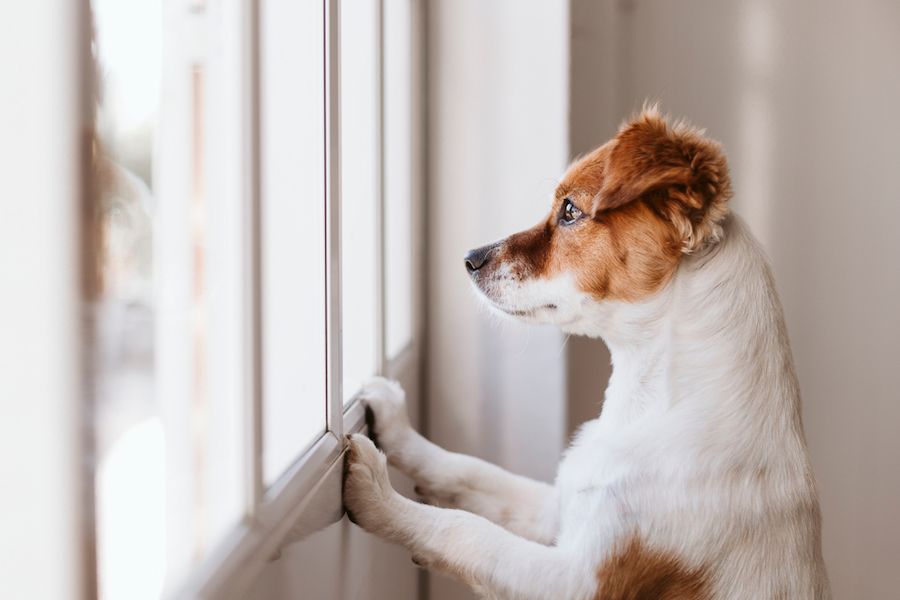6 Ways To Help Your Pet Avoid Separation Anxiety

As more companies wind down their work-from-home policies and kids head back to school, pets can have a hard time adjusting to a newly empty house. Whether you got your dog during COVID lockdowns or it has simply grown accustomed to having the whole family home, the readjustment period can be a tough one.
Luckily, there are several steps you and your family can take to ease and avoid any separation anxiety your beloved pet experiences. Follow these six steps for a smooth transition.
1. Work up to longer periods away
Your dog may not have a lot of experience spending time at home alone. There are so many dog-friendly spots these days, you may have grown accustomed to bringing your pooch with you wherever you go. Before you start spending eight hours or more at the office, help your dog transition by leaving him or her alone for shorter periods of time.
This gives you an idea of how long your dog can go without using the bathroom inside and also provides insight to any behavioral issues you may need to work on, like chewing furniture or the TV remote. Incrementally work up to a full day away so your pet is prepared.
2. Start each day with exercise time
Before you go to work and send the kids to school, carve out some time for your pet as well. Aim for at least 20 minutes of exercise time before it will be indoors all day. That could be simply playing in a fenced yard before everyone leaves, or with a nice walk. It’s one more thing to add to your list before heading out the door, but letting your dog burn some energy early in the day will set them up for success after you’re gone.
If your budget and comfort level allows, you could also schedule a midday dog walker. And if your older kids get home before you do, assign them some afternoon play time to give your dog some more exercise each day.
3. Use crates responsibly
Crate training provides benefits to you and your dog in a number of ways. First, it can help your pet strengthen its bladder since dogs strive to keep their sleeping areas clean. And being kept in a confined space can actually provide your dog with comfort while you’re away because it’s viewed as a place of safety and security. For you, of course, it reduces messes at home, from chewing on things to having an accident in a hidden corner.
When choosing a crate for your dog, make sure it’s the right size. It should be about four inches taller and longer than your pet’s height and length measurements. This gives them enough room to move around without being too spacious.
4. Invest in puzzles
Giving your dog some entertainment while you’re away from home is a great way to stimulate his or her brain and even tire her out throughout the day. There are all kinds of puzzles that hide treats and keep the dog busy trying to figure out how to find them.
Even some plush toys or interactive toys filled with peanut butter give your dog a healthy distraction rather than simply waiting for everyone to get back home. Peanut butter is usually safe for dogs in moderation — but be sure to check the ingredients and avoid brands that contain xylitol, which can be harmful for your furry friend.
5. Provide a calming environment
Take a few extra steps to create a serene environment while your dog is home alone. Using a noise machine or putting on a dog channel can block out noise from outside and reduce your pet’s stress levels. Also consider draping a blanket over the crate to create an even cozier ambience — bonus points if it’s one that you or your kids have already used so the dog is comforted by your scent. It can also help to keep the curtains or blinds so the dog doesn’t get upset by squirrels or people walking by.
If you do suspect your dog of experiencing anxiety while you’re gone, CBD oil and treats are gaining popularity as a remedy. In addition to having a calming effect, research has shown that these treats can also help with digestion and inflammation. Just remember to read the dosage recommendations on the packaging or talk to your vet if you’re unsure.
6. Head out with confidence
It can be tempting to fawn over your dog every time you head out the door. But in reality, this behavior actually causes your pooch more stress. Instead, confidently walk out the door without looking back, even if your dog whines on your way out. If you’re giving off negative emotions, your dog will pick up on these cues. Just walk straight out the door so your dog recognizes that this new routine is nothing to get excited about.
Final thoughts
Leaving your dog home alone while you go back to work doesn’t have to be stressful. Instead, give your dog solid training in advance, then make a few adjustments to ensure he or she is comfortable and stress-free. Once you both get the hang of it, you won’t even worry about walking out the door each morning.


